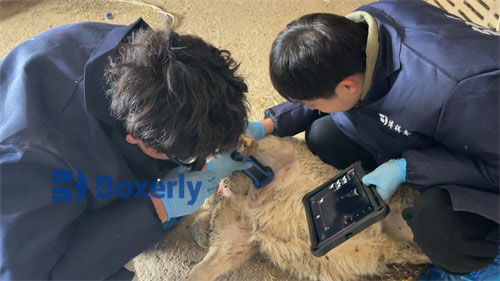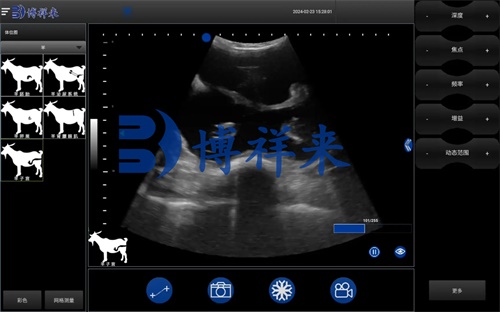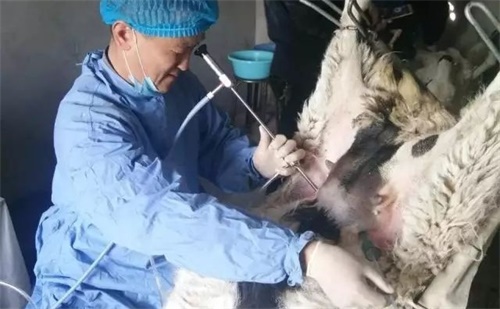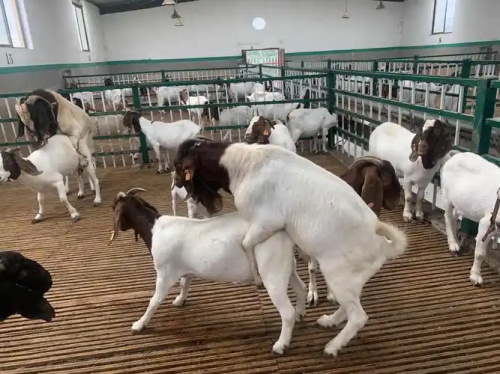As a sheep farmer, one of the most important aspects of reproductive management is knowing whether your ewes are pregnant—and knowing it early. Timely pregnancy detection is essential for planning feeding schedules, managing herd size, allocating lambing resources, and improving overall reproductive efficiency. Around the world, producers use a few key methods to determine pregnancy in sheep. En este artículo, we’ll explore and compare three of the most common techniques: veterinary ultrasonography, laparoscopy, and teaser ram detection (also called teaser male testing). Drawing from global best practices, field experience, and economic considerations, this comparison can help you choose the right approach for your farm.

Understanding the Importance of Pregnancy Diagnosis in Ewes
Pregnancy diagnosis in sheep isn’t just about curiosity—it’s a powerful management tool. By confirming whether a ewe is pregnant, farmers can:
-
Avoid wasting feed on non-pregnant animals.
-
Plan lambing dates more accurately.
-
Separate pregnant and open (non-pregnant) animals for targeted care.
-
Detect reproductive issues such as early embryonic loss or infertility.
-
Improve conception rates over time through better data.
This becomes even more important in large-scale commercial operations, where reproductive efficiency directly impacts profitability.
Let’s now delve into the three primary methods of diagnosing pregnancy in ewes.
Method 1: Veterinary Ultrasonography (Sheep Ultrasound)
Veterinary ultrasonography—commonly called “sheep ultrasound” in farming circles—is one of the most widely used and reliable tools for diagnosing pregnancy in ewes worldwide. The B-mode (brightness mode) ultrasonido, a type of real-time imaging, is particularly suited for this task.

How It Works
A trained technician or veterinarian applies an ultrasound probe to the ewe’s abdomen, usually around 30 Para 90 days after mating. The image produced allows the operator to visualize fluid-filled uterine structures, fetal movement, heartbeat, and sometimes fetal number.
International Perspective
In countries like Australia, the U.S., and the U.K., ultrasound is widely used due to its speed, accuracy, and non-invasive nature. Many farms hire mobile technicians who scan hundreds of ewes per day using handheld units. The real-time feedback allows for instant sorting decisions.
Accuracy and Efficiency
Ultrasound can detect pregnancy with over 95% accuracy from 35 days post-mating. It’s fast (5–10 seconds per ewe) and provides valuable data on fetal count and viability.

Cost Consideration
Let’s break it down with a 1000-ewe farm example. Suppose three farms share a sheep ultrasound machine worth RMB 150,000–250,000 (approx. USD 20,000–35,000), with a lifespan of 10 years. That’s RMB 5,000–8,000 annually. Add technician fees and testing costs—around RMB 20,000/year—and the total is RMB 25,000–30,000 annually. This brings the per-ewe cost to just RMB 25–30 per year (approx. USD 3.50–4.20).
Pros
-
Highly accurate, especially after day 30
-
Non-invasive and safe for both ewe and fetus
-
Fast, scalable, and practical for large herds
-
Provides real-time fetal health and number assessment
Cons
-
Requires trained personnel
-
Initial equipment investment is high
Method 2: Laparoscopy (Endoscopic Observation)
Laparoscopy is a more invasive but visually direct method for pregnancy diagnosis. It involves inserting a small camera (laparoscope) into the abdominal cavity to visually confirm the presence of a fetus or corpus luteum on the ovaries.

How It Works
A veterinarian performs minor surgery under local anesthesia. The ewe is restrained, and a small incision is made near the abdomen to insert the laparoscope. This allows direct visualization of the reproductive organs.
International Perspective
Laparoscopy is widely used in embryo transfer programs or in research contexts where accuracy is critical. While not as common in everyday commercial operations, it remains a valuable diagnostic tool, especially when managing valuable breeding stock or synchronizing estrus cycles for embryo transfer.
Accuracy and Efficiency
It provides near 100% accuracy when performed correctly. It also allows evaluation of reproductive health, ovarian condition, and uterine abnormalities.
Cost Consideration
Using the 1000-ewe example, a farm may require 3 laparoscopic units worth RMB 200,000–300,000 (USD 28,000–42,000), lasting 10 years. That’s RMB 20,000–30,000/year. Annual labor and procedure fees may reach RMB 80,000–90,000. Sin embargo, due to a 20–30-day reduction in diagnosis time compared to teaser ram methods, feed savings can total RMB 40,000–60,000. The total cost per ewe per year is RMB 60–80 (USD 8.50–11.30).
Pros
-
Extremely accurate, even at early stages
-
Valuable for high-value breeding programs
-
Can identify ovarian or uterine issues
Cons
-
Invasive and requires minor surgery
-
Expensive in terms of equipment and labor
-
Not ideal for routine mass diagnosis
Method 3: Teaser Ram Detection (Ram Testing)
One of the oldest and most natural methods of pregnancy diagnosis involves using teaser rams—males rendered infertile (often by vasectomy) but still hormonally active. They’re introduced to the flock after mating to detect which ewes are returning to estrus.

How It Works
Teaser rams are introduced 14 Para 17 days after mating. Ewes that come back into heat and accept the teaser likely failed to conceive. Those that reject the teaser are presumed pregnant.
International Perspective
In extensive grazing systems such as those in New Zealand, the U.S., and parts of South America, this method remains common, particularly where equipment or veterinary access is limited.
Accuracy and Efficiency
While low-tech, this method offers reasonable accuracy—around 85% if done properly. Sin embargo, it is limited in precision and cannot detect embryonic loss or multiple pregnancies.
Cost Consideration
A 1000-ewe operation might keep 30–40 teaser rams, con 20 additional young rams in reserve. These rams cost RMB 40,000–50,000 (USD 5,600–7,000) and last about three years, giving an annual amortized cost of RMB 10,000–20,000. Feeding and labor costs total RMB 40,000/year, resulting in a per-ewe cost of RMB 50–60 (USD 7.00–8.50).
Pros
-
Natural, low-tech, and easy to implement
-
No need for specialized equipment
-
Suitable for remote or low-resource farms
Cons
-
Less accurate than modern methods
-
Cannot determine fetal number or viability
-
Teaser rams still require management and feeding
Cost Comparison Summary
| Method | Annual Cost (per ewe) | Accuracy | Invasiveness | Notes |
|---|---|---|---|---|
| Ultrasonography | RMB 25–30 | 95–98% | Non-invasive | Best for large-scale use |
| Laparoscopy | RMB 60–80 | ~100% | Minimally invasive | Ideal for embryo transfer programs |
| Teaser Ram Testing | RMB 50–60 | ~85% | Non-invasive | Traditional and low-tech |
Which Method Is Right for You?
Choosing the right method depends on several factors:
-
Farm size: Large farms benefit most from ultrasound due to scale efficiency.
-
Presupuesto: Teaser rams offer a lower upfront cost but may be less efficient in the long run.
-
Technical support: Laparoscopy requires trained veterinary support.
-
Reproductive program goals: Precision programs (like AI or embryo transfer) may justify higher-cost methods.
-
Infrastructure and geography: Remote farms may rely on simpler methods due to logistics.
Global Trend: A Shift Toward Precision
Around the world, there’s a trend toward more precise, technology-driven livestock management. Ultrasound machines are becoming more affordable and portable. In some regions, drones and automated weighing systems are being paired with reproductive tracking apps, integrating ultrasonographic data to predict birthing windows and optimize nutrition in pregnant ewes.
Conclusión
Pregnancy detection in ewes is no longer just a guessing game. Whether you run a commercial sheep farm in Australia, a breeding station in Europe, or a small-scale operation in the U.S. Midwest, there’s a method that fits your goals, resources, and management style.
Veterinary ultrasonography stands out for its combination of accuracy, velocidad, and cost-efficiency—especially when shared across farms or integrated into a broader reproductive program. Laparoscopy, while costly and more invasive, provides unmatched clarity for high-stakes breeding decisions. And teaser rams, though old-fashioned, remain a useful tool in low-resource settings.
Ultimately, the best approach is the one that helps you make timely, informed decisions about your flock, improves productivity, and supports animal welfare. As technology evolves, more farmers globally are embracing tools that enhance reproductive success—one pregnant ewe at a time.